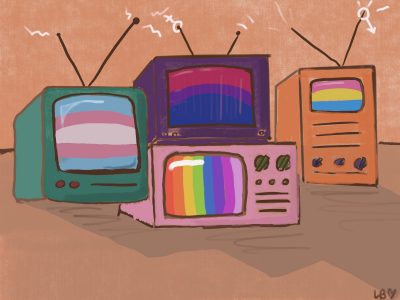A man and a woman brush hands while kneeling to pick up a fallen cabbage. Sparks fly. Romantic music starts playing. The camera zooms into her face, then his, then back to hers. Finally, we see a wide shot of the clandestine meet-cute.

It’s a classic scene in any love story. But this isn’t that type of love story. It’s not about crushes or love triangles or falling in love — it’s about what it means to not be able to fall in love.
In the first few minutes of “Koisenu Futari” we are introduced to the pivotal question of the series, translated from Japanese: “There’s nobody who can’t fall in love, right?” The show explores this question for the rest of its eight episodes through the perspective of our two main characters, Sakuko and Takahashi.
Sakuko is a normal office worker who seems to have the worst luck when it comes to romance. She’s oblivious to her coworker’s crush on her, prefers to hang out with friends rather than go out on dates and doesn’t seem to understand everyone’s preoccupation with romance.
After rejecting her coworker and finding out that he’s left their department, being told by a friend that she “needs to grow up” and finding out that her parents think she needs to get married soon, Sakuko goes to the internet for help. It’s then that she stumbles upon a blog about being aromantic and asexual, or aroace for short.
It turns out the blog is written by a grocery store worker, Takahashi, who she met earlier that week. She and Takahashi end up talking about what it means to be aroace, and eventually Sakuko –– who desperately wants independence without the need to get into a relationship –– proposes that they move in together.
“Koisenu Futari” makes a point to show how being aroace isn’t due to some traumatic event and never questions the two main character’s identities. Rather, it explores how fulfilling platonic relationships can be, with Sakuko and Takahashi finding companionship with each other.
I really appreciated that Sakuko and Takahashi are at different points in their discovery of being aroace. While we get to experience Sakuko’s journey with her, Takahashi has already come to terms with who he is and is confident in himself.
It’s very rare for queer main characters to be fully confident in their sexualities, so it was refreshing to have Takahashi’s character arc focus on something separate from his sexuality. We also get the inverse in Sakuko –– who’s in the process of discovering her sexuality.
The series does a great job at highlighting Sakuko’s newfound elation in her sexuality. While we do get some moments of contemplation and occasional struggles with her identity, we mainly experience the jubilation it feels to finally have a community who understands you. In my opinion, that was what set “Koisenu Futari” apart from others.
Sakuko and Takahashi are also both fully functioning and capable adults –– they’re not sliding by in life and nor are they considered outsiders from the people around them. I think this decision allows the audience to recognize them as full people separate from their sexualities –– they have interests and desires that have no connection to being aroace.
I also loved that “Koisenu Futari” challenges its side characters’ beliefs. It doesn’t imply that aroace people can only find meaningful connections with other aromantic and/or asexual people. Rather, it gives Sakuko and Takahashi a support system both in the aromantic and asexual communities while also showing their close relationships with other friends and family who aren’t aromantic or asexual.
It’s easy in the sea of couples around us to forget that love is more than just romance. It’s a connection between two people, a relationship that’s worth more than anything.
“Koisenu Futari” answers the question posed in its first episode — “There’s nobody who can’t fall in love, right?” — by showing the audience how rich and fulfilling a life with a platonic partner can be. It reminds us that living life being true to yourself is always worth more than living it for someone else.
Sinqueerly Yours,
Kal Hawley





















































































































